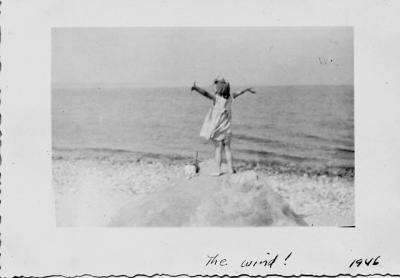For Love of the Sea

To this day, she can’t look at the photo without silently recharging emotions her mother had captured that warm East Hampton summer day in 1946. Sand pail by her bare feet, her cotton summer dress pressed against her back, she faced the sea she would come to love so much. She was barely 2 1/2, and the wonder of the saltwater, sand, and sea life became the foundation of her lifelong affair with beaches and oceans, especially on the South Fork.
Beryle Huntting Stanley, who was born in 1904 on East Hampton’s Cedar Street, added the year and the title “The Wind!” — sensing the love of place her daughter, Carol, was developing on those summer vacations to uncle Judson Banister’s Three Mile Harbor camp.
Jud, as he was known to friends and family, then into his 10th year as village mayor, enjoyed the company of his only niece’s child, especially delighting her with Three Mile Harbor and Gardiner’s Bay’s seafood bounty, shucking clams and scallops in his camp basement. But for young Carol the ocean’s edge held the strongest affection. Standing on the shore, her tiny arms outstretched to catch the breeze like a seagull, she gazed out to sea, lost in this world tugging at her.
Jud built the camp in 1919 shortly after he and five young local businessmen bought adjoining lots on Three Mile Harbor’s east shoreline from John Edwards. Carl Reutershan was Jud’s neighbor to the south. Black Marsh was to the north, home for years to Juan Trippe’s seaplane before he created Pan American Airways. Trippe later sold his lot to the Grom brothers, who developed Shagwong Marina. These camps became the scene of many joyous parties and social events for locals, often wrapping up late in the evening after they’d devoured meals of fresh-caught seafood and watched sunsets worthy of a painter’s dream.
For young Carol, her parents, and later her baby brother, the camp was simply heaven on earth. Each summer as August approached she strained with anticipation during the New London to Orient Point ferry ride and the seemingly never-ending drive through Riverhead and on to East Hampton. Oh, what wondrous days lay ahead. That ride was never quick enough, and the trip home always came too soon. In between was the stuff of dreams that built up all winter and spring, coiled in her, waiting to unwind at Jud’s glorious camp.
East Hampton’s affinity for the beach guaranteed that time spent at the camp would be the hub of spokes leading to exotic places — exotic to a 2-year-old even though nearby. Maidstone Park, Main Beach, Sammy’s Beach, the Montauk Lighthouse: These were adventurous playgrounds to delight any child.
Jud docked his beloved Jersey boat, the Kema, at the head of the harbor, ready to take his anxious great-niece and great-nephew picnicking and fishing in nearby Gardiner’s Bay. The memories of those fishing trips and the mystery of what she would pull up on her handline, or Jud teasing her with a freshly shucked oyster on the end of his penknife, still bring smiles. She shuddered and swallowed but never got used to the slippery oysters, Jud joking, “These get $3 apiece in the city.”
For Carol, the beaches were indeed places of enchantment, and they stimulated a developing imagination. Places of constant change and mystery, especially at low tide, when nature’s debris revealed so many treasures. All kinds of scallop, clam, and other shells, sand dollars, star and jellyfish, and those funny little hermit crabs tickled heart and mind. The salty, musky smell of a receding tide only enhanced the visual memory.
But for Carol, the camp was thevery special place. From her small upstairs bedroom, she could see the Texaco sign down harbor, and she would be lulled to sleep by the soft sounds of lapping waves, the salty smell of the bare rafters and studs of her room, and the muffled voices of the adults downstairs on the screened porch.
She loved that porch, with its swings and views of sunsets and boats returning to moor each night. It was a gathering place for her family almost every evening after dinner. From there, steep steps down to the shoreline invited her to explore, and just offshore, Jud’s houseboat, Sunshine, was the subject of many fascinating stories from before her time.
Abundant bird life added character to the atmosphere, seagulls, loons, ducks, and songbirds exhibiting their own differing behaviors. Sandpipers were real fun — one, two, a handful, or a crowd, they amused. And when the crowd took flight the ballet began. All a source of enjoyment and fascination for a young mind.
Her mother recorded more photographic memories of Carol with her friend Nancy Parsons at Maidstone and Main Beach. Later years included Rick, her younger brother, building on images she would keep forever. Each season added to the wondrous mosaic of memories from that special place.
But what her mother captured in that 1946 photo was the essence. “The Wind!” caught her enthralled daughter’s arms outstretched, embracing the magical world of the sea with every ounce of her being. A place where a little girl could let her mind wander with the breeze at her back, once again captured . . . by the wind!
You can go back, and she still does.
Steve Rideout and his wife, Carol Stanley Rideout, live in Hampden, Me. They regularly visit East Hampton to research family history.
